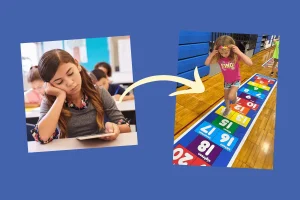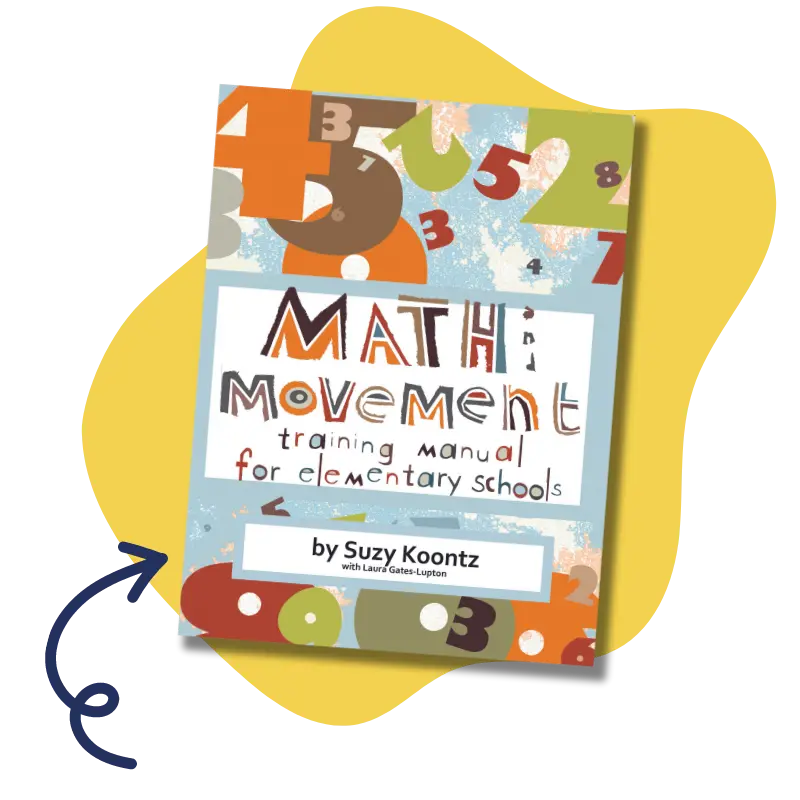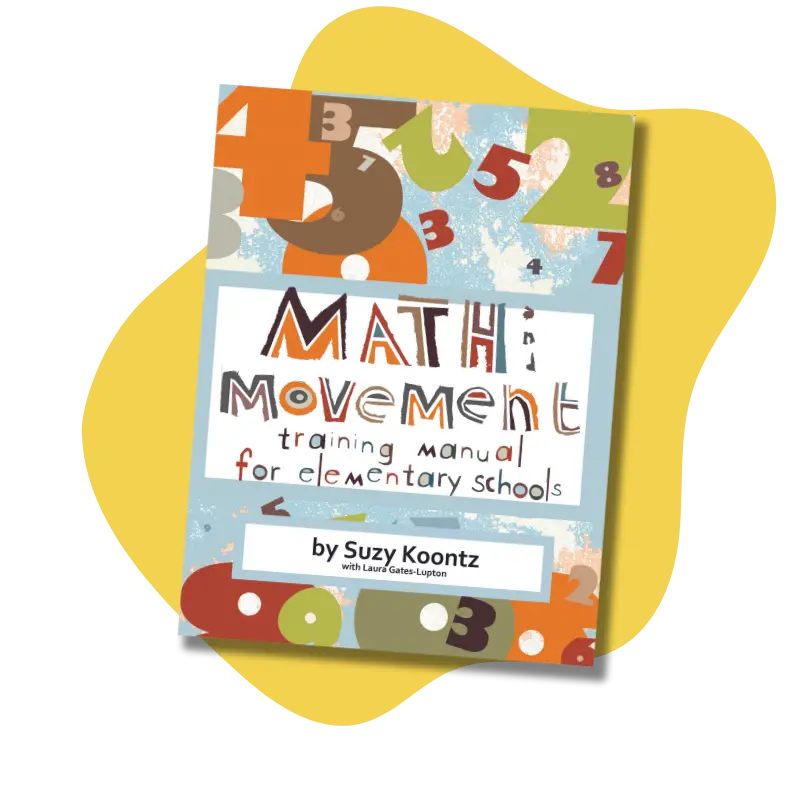
- Trusted by Over 2000 Schools Nationwide
- Top-Rated PD Provider ★★★★★ 4.77
- Save with our Kits & Packages – Shop Now! →

According to Idaho Ed News, surveys found that only 46% of students report feeling actively engaged during class. This statistic is concerningly low, and many educators are searching for interactive teaching methods to enhance their lessons. We’re sharing Math & Movement’s active learning strategies to increase student engagement. Adding movement to lessons is a game-changer for engaging students in math and other subjects.
Movement isn't just for recess
Want to get started with movement-based learning right now? Enter your email to get our training manual with over 250 active math movements. No materials necessary!

See how simple adding movement can be!
A recent study by the National Math Foundation found that kinesthetic activities significantly increased engagement across a sample size of 492 students. The study, known as The Mighty Multiplication Project, consisted of an 8-week math intervention for 3rd through 5th graders. This intervention focused on incorporating kinesthetic learning strategies into multiplication lessons.
Over the eight weeks, the students participated in various movement-based learning activities, including active math movements and jumping on Math & Movement floor mats. Teachers continued to use traditional teaching activities, including whiteboard work, flashcards, and worksheets, along with the new kinesthetic activities.
In conclusion, the data showed a highly significant relationship between the type of activities and the level of student engagement. Active learning strategies brought more engagement than traditional activities.


“Student and teacher feedback indicated that kinesthetic activities fostered greater instances and higher levels of engagement, enthusiasm, and positive attitudes towards mathematics in general and multiplication in specific,” the Mighty Multiplication Project report reads.
Active learning transforms passive listening into a hands-on experience. When teachers use interactive teaching methods in the classroom, students become active participants in the learning process rather than just observers. Moreover, they will begin to learn the material on a deeper level. Engaging directly with lessons through interactive exercises will help them build a stronger foundation in every subject.
Interactive teaching methods bring energy and engagement to classrooms. We know that movement-based activities, in particular, increase student engagement. Unlike traditional lecture-style teaching, interactive methods encourage and improve student participation, fostering curiosity and motivation to explore new ideas.
Here are the five main types of active learning strategies that are particularly effective in increasing student engagement:
Below, we’ll describe the different types of active learning strategies and share a Math & Movement activity as an example.
Think-pair-share activities are great for improving student participation and engaging students in math. Complete these activities progressively, moving from one step to the next.
To begin, give students a question to think about individually, giving them time to formulate a plan. Once they have prepared, they pair up to discuss their ideas. This method allows them to practice expressing their thoughts clearly.
Finally, each pair of students takes turns sharing insights with the class. This helps everyone improve their understanding by working together.
The Add/Subtract (1-100) is our large hundred number grid! It is one of our most popular and versatile materials, making many interactive teaching methods possible. The activity “Unknown Addend” is a perfect example of a think-pair-share activity for first graders.
First, write different addition problems with a missing addend on notecards. Write enough so that each student has at least one. Next, scatter them around the edge of the mat. Explain how to use the mat to find the missing addend.
Ask two students to pair up and pick a card. Have the first student stand on the sum and the second on the known addend. Ask the students to think about what the missing addend is in their heads first.
Then, have the pair of students share their answers with each other. Once they have discussed, ask them to return to standing on their numbers. Next, ask the student standing on the known addend to step and count the blocks aloud until they are on the one their partner is on. Have one student write the missing addend on the card.
Finally, have the pair share how they found the answer and any observations they made on the mat with the class. Continue the activity with different cards and new pairs of students.
Group discussions are great for engaging students in math. This active learning strategy invites students to explore different perspectives on a topic. Expose students to new ways of thinking by having them share ideas and listen to their peers.
A structured discussion allows students to ask questions, make connections, and refine their viewpoints. It can lead to a more inclusive and thoughtful classroom environment where everyone’s voice matters.
The Cartesian Coordinate Hop is a large coordinate plane depicting the X and Y axis with the points -10 through 10 labeled. It features all four quadrants in different colors with precise grid lines for graphing practice. The “Put Me Together” activity includes group discussion to increase student engagement during geometry lessons on reflections, translations, and rotations.
First, have two groups of students stand on the mat to make two identical figures. For example, eight students could make two 4×4 squares. Once students stand on the mat in this formation, have them place an object at their feet and step back from the mat.
Next, ask students to describe and act out what movements they would need to take to end up on top of each other’s shape. Finally, have them discuss as a group and act out their answer on the mat.
Problem-solving exercises encourage students to put theory into practice. These activities help students pay attention to the steps they take to find an answer.
Math & Movement’s floor mats are great tools for developing problem-solving skills. Students think through problems as they move across the mats. The actions of the body and mind work together to strengthen each student’s comprehension.
Working through problems helps students connect ideas and see the lesson’s practical application. Problem-solving exercises create a meaningful and memorable learning experience by challenging students to think critically.
This hop mat depicts quadrant 1 of the coordinate plane. The grid extends from 0 to 20 on the X and Y axes. The activity “Same Area/Same Perimeter Challenge” is an excellent example of a problem-solving student engagement strategy.
First, have students make a rectangle on the mat by standing on it or using string, popsicle sticks, bean bags, or other objects as markers. Then, challenge students to make another rectangle with the same perimeter but a different area or with the same area but a different perimeter.
Another effective student engagement strategy is gamified learning, which uses elements like points, badges, or levels to make lessons more engaging. Gamification taps into students’ natural interest in play, making learning enjoyable and motivating them to stay involved. Through friendly competition and achievable goals, students gain a sense of accomplishment that reinforces their desire to learn.
Furthermore, games transform abstract concepts into interactive experiences. These experiences help students develop a hands-on, tactile understanding of numbers, equations, and patterns.
Many kinesthetic activities can feel game-like because they involve physically moving to accomplish a goal. Adding a little bit of competition will motivate students to learn what they must know to keep up with other students.
This large format number line mat has blocks for each multiple of 3. Each block contains the numeral, number word, and equivalent symbols to help students master skip counting and multiplication. The “Bean Bag Baseball” activity is the perfect example of gamified learning because students must know their multiplication by 3s to win!
Begin by dividing your class into teams. Place a bucket or basket at the end of the Skip Counting by 3s mat after 30.
Have one team line up in a single file line behind zero. The other team will wait off to the side of the mat until it is their turn “at bat.” The goal of the game is to get the most bean bags into the bucket before the rounds/innings are over. You can determine how many rounds the class plays.
Give the first player a multiplication by 3s question. Then, have them hop to their answer and make sure they are correct. If the answer is correct, they will toss their bean bag into the bucket at the end of the mat. If incorrect, they get a “strike” and do not get to throw their bean bag.
Repeat with the next student in line. You can decide how many strikes each team gets before switching to the next team.
Finally, at the end of the last inning, the team that got the most bean bags into the bucket throughout the game wins.
Peer teaching is another interactive approach that allows students to take on an instructive role within the classroom. By explaining concepts to their classmates, students reinforce their own understanding while building communication skills. Peer teaching also promotes collaboration and trust as students learn to value each other’s perspectives and input.
This large, colorful mat shows a times table, including products from 1×1 to 10×10. Each column and row has the numbers 1 through 10 on each axis to help students solve multiplication problems. While educators can use almost any Math & Movement mat in peer teaching activities, the “Multiplication Mayhem” activity is particularly valuable for third, fourth, and fifth graders mastering their times table.
First, write multiplication problems on notecards. Students can solve these problems using the mat. Pair an older student with a younger student or a proficient student with a student still learning multiplication.
Have the pairs find the first factor horizontally on the top of the mat. Next, have the pairs hop down that column until they land where the second factor is on the left-hand side of the mat vertically. The number they land on is the product!
We know that kinesthetic activities work as active learning strategies to increase student engagement. Engaging students in math is extremely valuable for individual development and academic achievement.
Movement-based activities specifically work to increase student engagement by:

Kinesthetic activities foster autonomy and self-efficacy. During the Mighty Multiplication Project, students participated in kinesthetic skip counting activities using Math & Movement floor mats. Afterward, they completed a multiplication worksheet. Students realized that by moving their bodies on the mat, they had gained the skills to solve the worksheet’s multiplication problems.
In essence, the students learned that their choice to participate impacted their learning. Their physical efforts paid off when the worksheet tested their mental skills. The kinesthetic activity empowered students to feel independent and confident in their academic abilities!
Young children never like to sit still for long. Kinesthetic activities encourage movement while still learning. In fact, movement has biological benefits. Physical activity boosts blood flow and oxygen levels in the brain, therefore improving comprehension and memory retention.
Students are more likely to stay engaged in math when their physical needs are met. Kinesthetic activities and interactive teaching methods allow them to expend energy rather than fight against it while sitting at a desk.
Students are challenged in a new way when coordinating a physical movement with a math concept. They see hopping down a mat as a new challenge or mission to complete. These new physical experiences keep students engaged in math.
Additionally, kinesthetic learners like to experience their learning. They learn best by interacting with their learning environment. With movement, students become physically active participants in their own learning, which is likely to keep them engaged.
Kinesthetic activities foster a collaborative learning environment. Students work together to move and solve problems. The classroom becomes a much more energized and interactive environment by nature during kinesthetic activities. Remember that students are more likely to stay engaged when they feel supported and like they belong in their class.
With mats like the Skip Counting Hops, it is easy for students to learn from one another. One student can hop down the mat to solve a multiplication problem. The other students can line up on the sides of the mat and count the number of hops aloud. They can also challenge the hopping student by calling out another multiplication problem to solve.

Effective student engagement strategies can transform a classroom, making learning an interactive, inclusive, and meaningful experience. Engaging students in math can be particularly challenging, but the interactive teaching methods we highlighted can help make the subject more enjoyable and approachable.
Many students feel intimidated by math, seeing it as complex or unrelated to everyday life. Math & Movement’s missing is to help children find joy and understanding in math while creating a comfortable environment for learning.
So, how do educators start increasing student engagement with kinesthetic activities? The answer is to start small. Incorporating just one or two active learning strategies can positively affect student engagement.
To begin, try incorporating active math movements into the school day. Students can do these movements without additional materials while sitting at their desks or traveling down the hallway. Download our FREE training manual for hundreds of ideas!
If you really want to boost student engagement, Math & Movement has a wide selection of kinesthetic learning materials, including floor mats and stickers. Our Math Kits include some of our most popular products.
We also offer professional development training webinars and a wide selection of lesson plan ideas on our activity database. We aim to make kinesthetic teaching strategies possible and accessible in your classroom!
One teacher who participated in the Mighty Multiplication Project shared the change they saw in their students after implementing kinesthetic strategies: “The students were highly motivated and engaged [as a result of the project]. Their attitude toward math was positive.”
Movement isn't just for recess
Want to get started with movement-based learning right now? Enter your email to get our training manual with over 250 active math movements. No materials necessary!
Subscribe to Our Newsletter
We never share or sell your data.
Please leave your email and a quick note for us. We will get back to you soon! In the meantime, here are answers to some of our most common questions:

Enter your email to get our training manual with over 250 active math movements. No materials necessary!
We never share or sell your data.